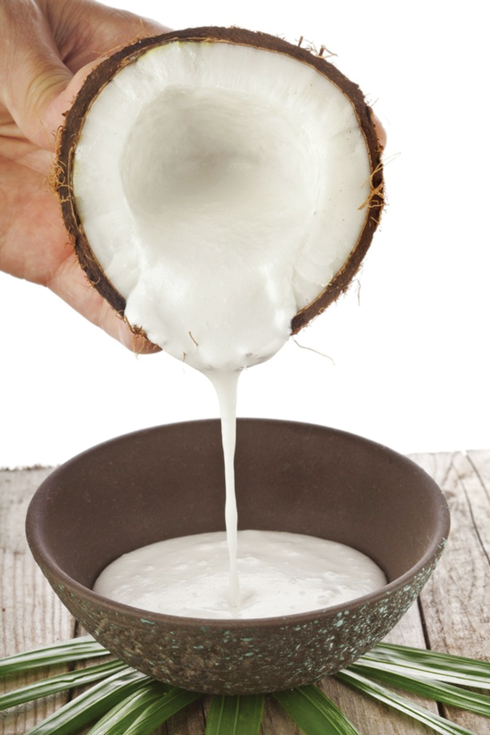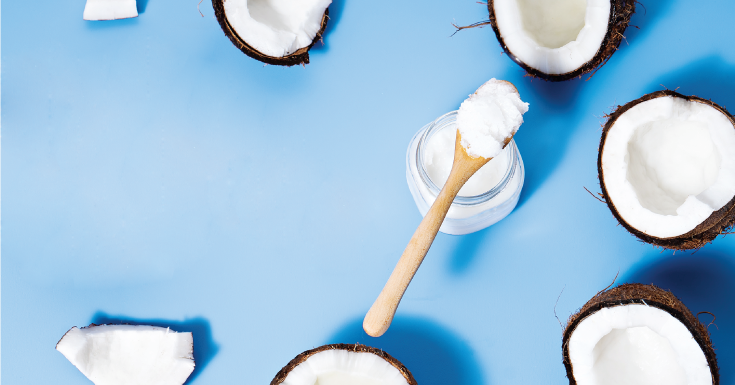What Is Coconut Milk?
Coconut milk comes from the white flesh of mature brown coconuts, which are the fruit of the coconut tree. The milk has a thick consistency and a rich, creamy texture. Thai and other Southeast Asian cuisines commonly include this milk. It’s also popular in Hawaii, India, South East Asia and certain South American and Caribbean countries. Coconut milk should not be confused with coconut water, which is found naturally in immature green coconuts.
Unlike coconut water, the milk does not occur naturally in liquid form. The solid flesh is mixed with water to make coconut milk, which is about 50% water. By contrast, coconut water is about 94% water. It contains much less fat and fewer nutrients than coconut milk.
Main point: Coconut milk comes from the flesh of mature brown coconuts. It is used in many traditional cuisines around the world.
How Is Coconut Milk Made?
Coconut milk is classified as either thick or thin, based on consistency and how much it’s processed.
Thick: Solid coconut flesh is finely grated and either boiled or simmered in water. The mixture is then strained through cheesecloth to produce thick coconut milk.
Thin: After making thick coconut milk, the grated coconut remaining in the cheesecloth is simmered in water. The straining process is then repeated to produce thin milk.
In traditional cuisines, thick coconut milk is used in desserts and thick sauces. Thin milk is used in soups and thin sauces.
Most canned coconut milk contains a combination of thin and thick milk. It’s also very easy to make your own coconut milk at home, adjusting the thickness to your liking.
Main point: Coconut milk is made by grating flesh from a brown coconut, soaking it in water and then straining it to produce a milk-like consistency.
Nutrients in Coconut Milk
Coconut milk is a high-calorie food. About 93% of its calories come from fat, including saturated fatty acids known as medium-chain triglycerides (MCTs).
The milk is also a good source of several vitamins and minerals. One cup (240 grams) contains:
Calories: 552.
Fat: 57 grams.
Protein: 5 grams.
Carbs: 13 grams.
Fiber: 5 grams.
Vitamin C: 11% of the RDI.
Folate: 10% of the RDI.
Iron: 22% of the RDI.
Magnesium: 22% of the RDI.
Potassium: 18% of the RDI.
Copper: 32% of the RDI.
Manganese: 110% of the RDI.
Selenium: 21% of the RDI.
In addition, some experts believe coconut milk contains unique proteins that may provide health benefits. However, more research is needed on this.
Main point: Coconut milk is high in calories and saturated fats called medium-chain triglycerides. It also contains many other nutrients.
 Effects on Weight and Metabolism
Effects on Weight and Metabolism
There’s some evidence the medium-chain triglyceride (MCT) fats in coconut milk may benefit weight loss, body composition and metabolism. About half the fat in coconuts comes from an MCT called lauric acid. Coconuts also contain small amounts of other MCTs, including capric acid and caprylic acid. Unlike longer-chain fats, these MCTs go from the digestive tract directly to the liver, where they’re used for energy or ketone production. They are therefore less likely to be stored as fat.
Research also suggests MCTs may help reduce appetite and decrease calorie intake, compared to other fats. In a small study, overweight men who consumed 20 grams of MCT oil at breakfast ate 272 fewer calories at lunch than those consuming corn oil. What’s more, the MCTs in coconuts can boost calorie expenditure and fat burning, at least temporarily. In a few controlled studies, obese people or those with heart disease who consumed coconut oil lost weight and belly fat. Heart health markers also improved. Although no studies have directly tested how coconut milk affects weight and metabolism, several studies show impressive effects from coconut oil and MCTs.
The same should apply to coconut milk, because it has the same fatty acids.
Main point: The MCTs in coconut milk may reduce appetite, increase metabolism and help you lose belly fat.
Effects on Cholesterol and Heart Health
Because coconut milk is so high in saturated fat, people may wonder if it’s a heart-healthy choice. Very little research examines coconut milk specifically, but one study suggests it may benefit people with normal or high cholesterol levels. This 8-week study of 60 men found that coconut milk porridge lowered LDL (“bad”) cholesterol more than soy milk porridge. Coconut milk porridge also raised HDL (“good”) cholesterol by 18%, compared to only 3% for the soy. Most studies of coconut oil or flakes also found improvements in LDL cholesterol, HDL cholesterol and/or triglyceride levels. Although in some studies LDL cholesterol levels increased in response to coconut fat, HDL also increased. Triglycerides decreased, compared to other fats. Lauric acid, the main MCT in coconut fat, may raise LDL cholesterol by decreasing the activity of the receptors that clear LDL from the blood. Results of two studies on similar populations suggest that cholesterol response to lauric acid may vary by individual. It may also depend on the amount in the diet.
In one study of healthy women, replacing 14% of monounsaturated fats with lauric acid raised LDL cholesterol by about 16%. In another study, replacing 4% of monounsaturated fat with lauric acid had very little effect on cholesterol.
Main point: Overall, cholesterol and triglyceride levels improve with coconut intake. In cases where LDL cholesterol increases, HDL typically increases as well.
 How to Use Coconut Milk
How to Use Coconut Milk
Although coconut milk is nutritious, it’s also high in calories. Keep this in mind when adding it to foods or using it in recipes.
Ideas for Adding Coconut Milk to Your Diet
- Include a couple of tablespoons in your coffee.
- Add half a cup to a smoothie or protein shake.
- Pour a small amount over berries or sliced papaya.
- Add a few tablespoons to oatmeal or other cooked cereal.
How to Select the Best Coconut Milk
Here are a few tips for selecting the best coconut milk:
- Read the label: When possible, choose a product that contains only coconut and water. Avoid questionable ingredients such as carrageenan.
Choose BPA-free cans: Purchase coconut milk from companies that use BPA-free cans, such as Native Forest and Natural Value. - Use cartons: Unsweetened coconut milk in cartons usually contains less fat and fewer calories than canned options. Look for brands without carageenan, such as So Delicious and Silk.
- Go light: For a lower-calorie option, select light canned coconut milk. It’s thinner and contains about 125 calories per half cup (120 grams) (35).
- Make your own: For the freshest, healthiest coconut milk, make your own with this simple recipe using shredded coconut: Homemade Coconut Milk.
Main point: Coconut milk can be used in a variety of recipes. Avoid types that contain questionable ingredients, or make your own at home.
How to Take Coconut Oil
*WARNING – refined or processed coconut oil can be bleached, over-heated, and chemically processed to increase its shelf-life. Processing the oil changes the chemical makeup and the fats are no longer good for you! SO INSTEAD – buy extra virgin coconut oil for the greatest health benefits.
Coconut Oil Has Fatty Acids That Are Good for You
You may have heard that while saturated fat was once thought to be a leading cause of heart disease, it’s now known to be not just beneficial but crucial for good health. The good news: coconut oil is one of the best sources of saturated fat on the planet. In fact, about 90 percent of the fat content in coconut oil is saturated fat.
Rather than clogging your arteries, damaging your coronary system and putting you on the fast track to a stroke, new information has emerged in a significant meta-analysis, which showed no significant evidence that saturated fat causes any of the above, but is in fact very good for you.
Coconut oil contains medium-chain triglycerides that can have therapeutic benefits for people with certain brain disorders, epilepsy, and may even help prevent Alzheimer’s disease.
Where Coconut Oil Has Been Used, People Thrive
As you look at the civilizations around the world that have consumed coconut oil for decades and even centuries, it’s clear there’s a difference, medically speaking, between those individuals and those of the so-called “enlightened” first-world countries.
They seem to be healthier! As an example, individuals in Polynesian populations such as those in Tokelau and Pukapuka, where people tend to eat a lot of coconut, were examined in light of their high saturated fat intake and low cholesterol and sucrose levels.
Researchers found that “vascular disease is uncommon in both populations and there is no evidence of the high saturated fat intake having a harmful effect.”
Another case in point is the Kitevan people in New Guinea, whose collective diet is untarnished by the food habits of the Western world. Besides eating a lot of tubers, fruit and fish, the people also consume coconut as a prominent staple.
None of the people involved in the study reported stroke, sudden death, weakness, brain diseases, or chest pain related to heavy lifting. Coronary artery disease was nowhere to be found.
The only inference that can be made is that, rather than being sick, weak and diseased, many populations around the world have managed much better than more “progressive” parts of the world on their traditional diets with the plentiful addition of coconut oil.
The good news: coconut oil is one of the best sources of saturated fat on the planet. In fact, about 90 percent of the fat content in coconut oil is saturated fat.
Triglycerides, Fat and Where It’s At
No matter where you travel, practically every place has been influenced by the Western diet, and not in a good way.
Where there’s obesity in large amounts of the population, there’s a very good chance you’ll find misguided and destructive eating habits such as low-fat diets along with too much processed, CAFO (concentrated animal feeding operation) meat and not enough vegetables and healthy sources of fat.
Some believe it’s all about calorie intake; however, people who have been paying attention to which foods are actually healthy and which are not understand this isn’t really the case. It’s about the substance behind the calories.
Medium-chain fatty acids or triglycerides (MCTs) in coconut oil amount to about two-thirds its total fatty acids. In explanation:
“Dietary fats are molecules composed of individual carbon atoms linked into chains ranging from two to 22 carbon atoms in length. Long-chain fatty acids (LCTs) ranging from 12 to 18 carbons long are the predominant form of fat in the American diet.
MCTs, by contrast, are composed of only six to 10 carbon links. Because of their shorter chain length, MCTs have a number of unique properties which give them advantages over the more common LCTs.”
The bottom line is, when you eat foods high in medium-chain triglycerides, your body benefits.
References:
https://authoritynutrition.com
https://draxe.com
http://articles.mercola.com
www.doctoroz.com
www.prevention.com


